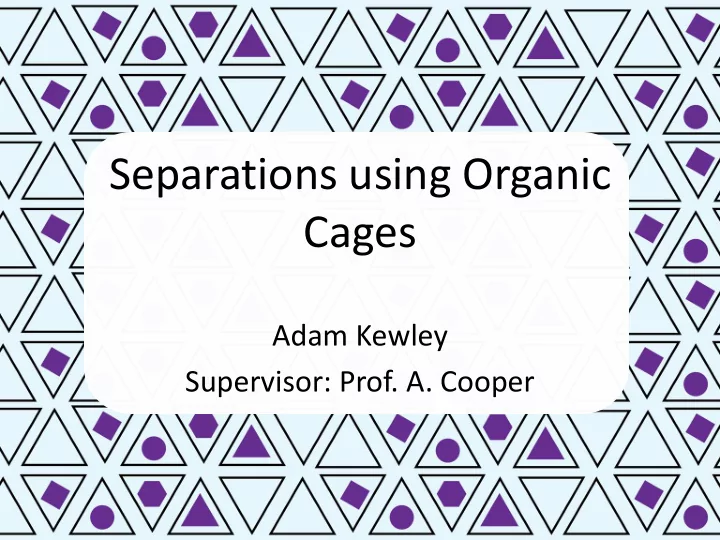

Separations using Organic Cages Adam Kewley Supervisor: Prof. A. Cooper
Overview • Why separation science • Cage compounds • Selective adsorption into a cage • Analytical separations using a cage
Why Separation Science? • The products we synthesize aren’t getting any simpler • Neither are our requirements. We still want robust analysis and pure products • Separations are a core solution for these requirements. Industrial separations are a multibillion pound industry. • Specialist solutions are very desirable. Especially in industry, a bespoke solution that works very well for a small group of compounds is desirable My focus is on exploiting a materials properties to perform specialist separations
This Presentation Focuses on Cage 3 ( CC3 ) • A soluble porous material • Made by self-assembly via imine condensation • Easy to make in the lab in high purity • Chiral precursor leads to chiral CC3 - R • Well studied, good foundation on which we can rationalize its behaviour
And a Lot of Chromatography Mixture Stationary Phase 1) Injection (t=0) 2) Separation 3) Detection t
With CC3 Control 1) Add Host Measuring Selectivity 2) Activate 3) Add Guest 4) Mix 5) Measure 6) Compare
Example Chromatogram Guest Mixture Intensity Guest Mixture + CC3 - R 9 10 11 12 13 Retention Time / min.
Computational Modelling Computational modelling was used to help understand why we • observe selectivity ( credit for the modelling goes to Linjiang Chen ) • It shows that a hydrogen bond exists between CC3 - R and ( S )-1- phenylethanol (1-PE). It doesn’t exist for the CC3 - R & ( R )-1-PE pair.
Bringing it All Together a b CC3 - R 30 30 rac - CC3 CC3 - S CC3 - R 15 15 rac - CC3 ee S (%) ee S (%) 0 0 -15 -15 CC3 - S -30 -30 0.5 1.0 1.5 2.0 1 2 3 4 5 Guest : Host (molar equiv.) Simulation • Competitive mechanism • Adsorption measurements ( left ) align well with models ( right ) • A reversible process that doesn’t change or consume CC3 Linjiang Chen et. al., Nature Materials , submission accepted.
Join the Dots o Components of a mixture will compete to adsorb onto CC3 Chromatographic separations work when components of have differing affinities for a stationary phase o The adsorption is reversible and involves no chemical or physical change A good column doesn’t change, chemically or physically, when separating mixtures
Make a Column Containing CC3 Take advantage of organic cages solubility: a) Cast a film of CC3 - R inside a capillary column Or b) Precipitate rac - CC3 in a controlled manner to give us nanoparticles to fill inside a capillary column
Separating Xylenes Elute Together Intensity rac - CC3 Column Blank Column 0 5 Retention Time / min.
All Isomers of Hexane Elute Together Blank Control Intensity SP-2100 Control rac - CC3 NPs 0 9 Retention Time / min. Credit to Tom Hasell for capturing the SEM images.
Chiral Separations R & S Together R S Intensity CC3 - R Column Blank Column 0 12 Retention Time / min.
Summary • Developed an easy method for measuring host-guest selectivity • Tried to understand the mechanism and factors that affect selectivity • Used that information to produce a working GC columns containing CC3 • The columns were able to perform some very difficult separations
Outlook • While separations on CC3 are great there is a selection of other cage compounds available which may be better at some separations • A literature method was used to make the CC3 coated columns. A commercial-grade production method would produce higher quality columns capable of even more difficult separations
Acknowledgements
Recommend
More recommend